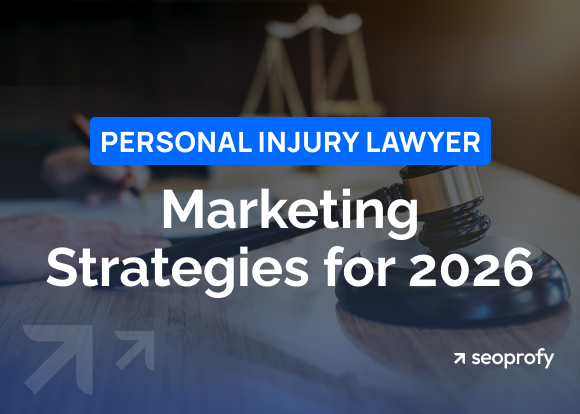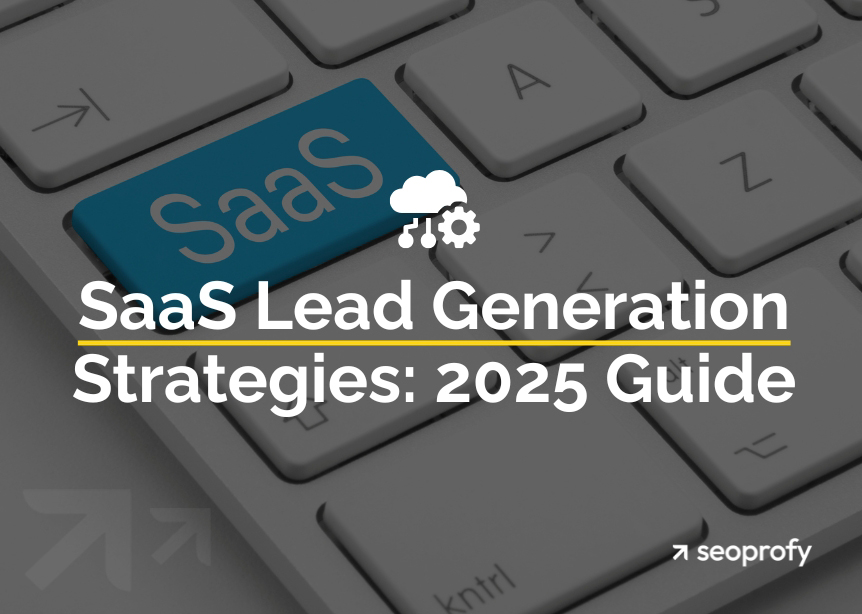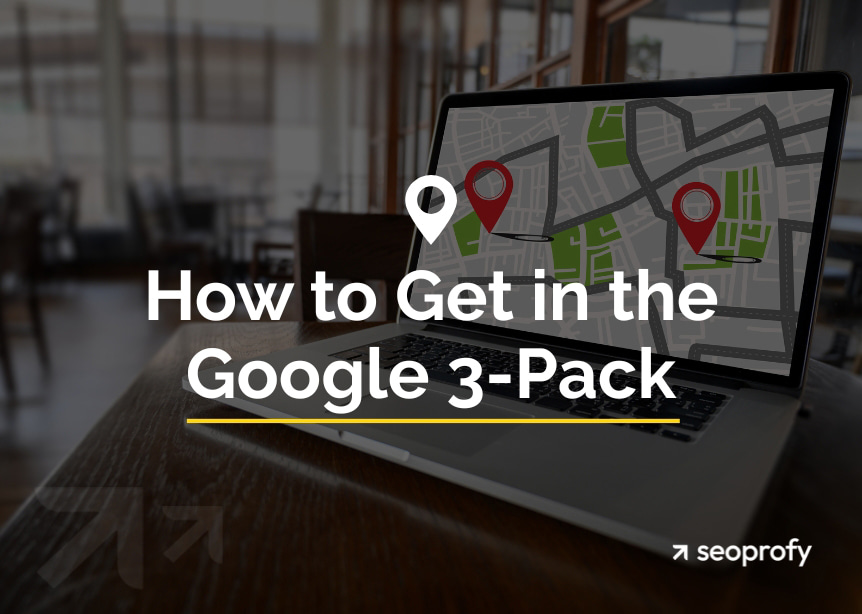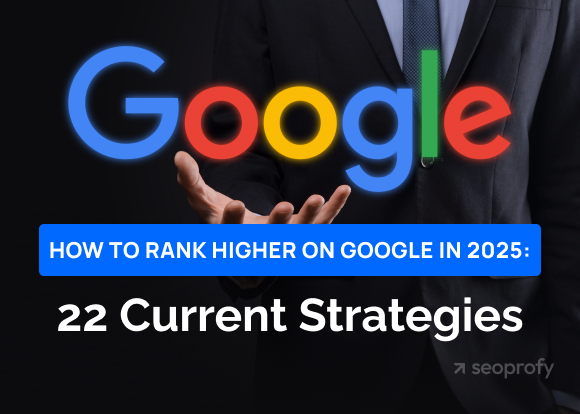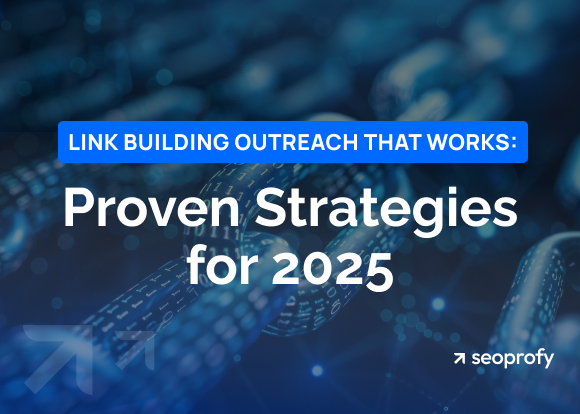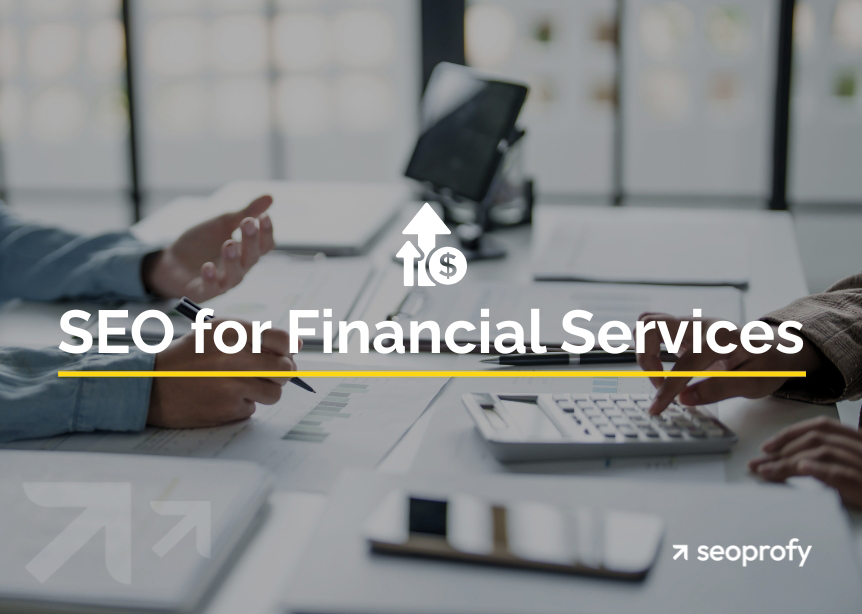SaaS SEO (search engine optimization for software as a service) is the practice of optimizing software websites to improve their visibility in search results, attract qualified leads, and gain more paying subscribers. It focuses on the entire customer lifecycle and combines keyword research, technical optimization, content writing, and link building to bring more people to the site and nudge them toward trying a product.
In this guide, you’ll learn five proven strategies on how to optimize your site for SEO. We’ll also share the tactics our SaaS SEO agency used to help one software client grow from 22K to 68K monthly visitors, so you can apply them and start seeing results for yourself.
- SEO supports long-term growth for software brands by steadily driving organic traffic without paid ads.
- In SaaS, sales take time and involve several people in the decision, so content needs to adapt to their different priorities and questions.
- Content marketing is a critical part of every SaaS SEO strategy and improves retention by 32%.
- Guest posts, partnerships, and digital PR are some of the ways SaaS companies can use to build high-quality links and stay competitive.
What Is SaaS SEO?
SaaS search engine optimization (SEO) is the process of driving organic traffic to your software website by optimizing it to rank higher on Google’s search results.
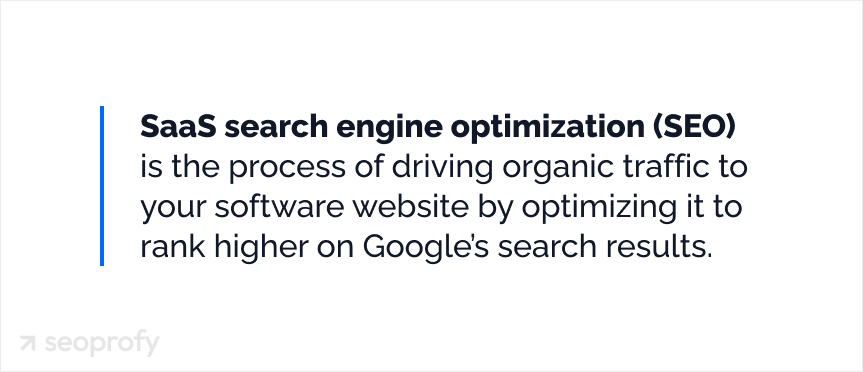
Key SaaS SEO components include:
- Researching relevant and high-intent keywords
- Creating content that answers user questions and shows how the product fits their needs
- Optimizing meta tags, headings, images, and internal links on each page
- Fixing technical issues that affect the user experience and indexing
- Earning links through mentions on trusted websites and guest contributions.
A combination of these strategies helps you align your website with what your potential customers are looking for and draw in customers throughout the entire buyer’s journey.
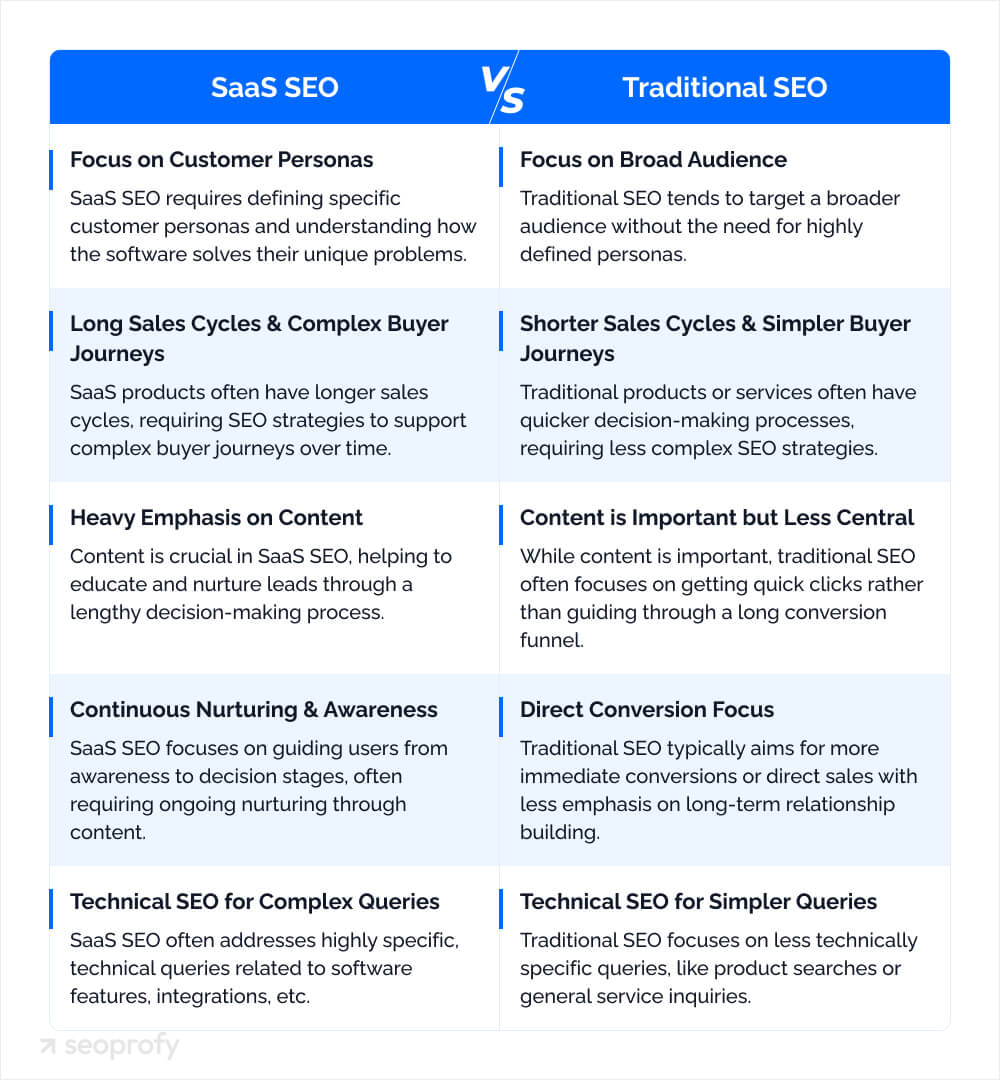
How Is SaaS SEO Different from Traditional SEO?
SaaS SEO and traditional SEO differ in a few ways. The main distinction is that in SaaS, you need to clearly define your customer personas and how your software can solve their problems. This is driven by the need to consider long sales cycles, complex buyer journeys, and highly specific technical queries.
Another thing about SaaS optimization is how it leans on content. If you look at companies such as HubSpot, Figma, and Zoom, all of them have invested a lot of effort into their content. This is directly connected to the long cycles in the SaaS space.
After all, choosing a CRM takes longer than, for example, buying running shoes. This means SEO campaigns in SaaS have to guide potential customers through the entire buying process, from getting to know your software (awareness) to buying a subscription (decision).
Why Should SaaS Companies Invest in SEO for Their Websites?
SEO helps software websites appear in organic search results exactly when people look for a tool or feature they offer. And we’re not talking about Google alone. Now that more and more people do their research in AI tools, SEO tactics also keep your product visible there.
Most of these tools pull their answers from existing online content. So when your pages are optimized and backed by credible links, your product becomes more visible in those results too. That said, here are a few benefits that SEO offers and why big SaaS brands keep investing in it:
More Qualified Traffic
The main advantage of SEO in SaaS is relevance. You target search terms that reflect real use cases and buying intent. So, the people landing on your site already have a problem and are evaluating options.
Lower Customer Acquisition Costs
Clicks in SaaS rarely come cheap, and depending entirely on paid channels can quickly drain budgets. Luckily, SEO offers a different dynamic. Once your pages are optimized and supported with trusted links, they keep attracting qualified traffic without repeat spending. Moreover, data shows that SEO brings an ROI of around 702% and drives more than half of the total revenue in SaaS.
Amplified Results from Other Marketing Channels
Paid advertising and social campaigns spark awareness, but your SEO efforts define how people move from curiosity to decision. After seeing an ad or a LinkedIn post, they often look up your product name or compare you with competitors. Strong organic visibility lets you guide that research instead of leaving it to chance.
At our agency, we craft personalized, data-driven strategies to help you attract qualified leads, rank higher for important keywords, and grow your user base. Book your free consultation with us to see better SEO results and enjoy:
- Higher rankings
- Better online visibility
- More demo requests

Top 5 SaaS SEO Strategies For Better Growth
Product-led companies compete in a crowded space. So, to help you come out on top, here’s a step-by-step SaaS SEO guide you can follow:
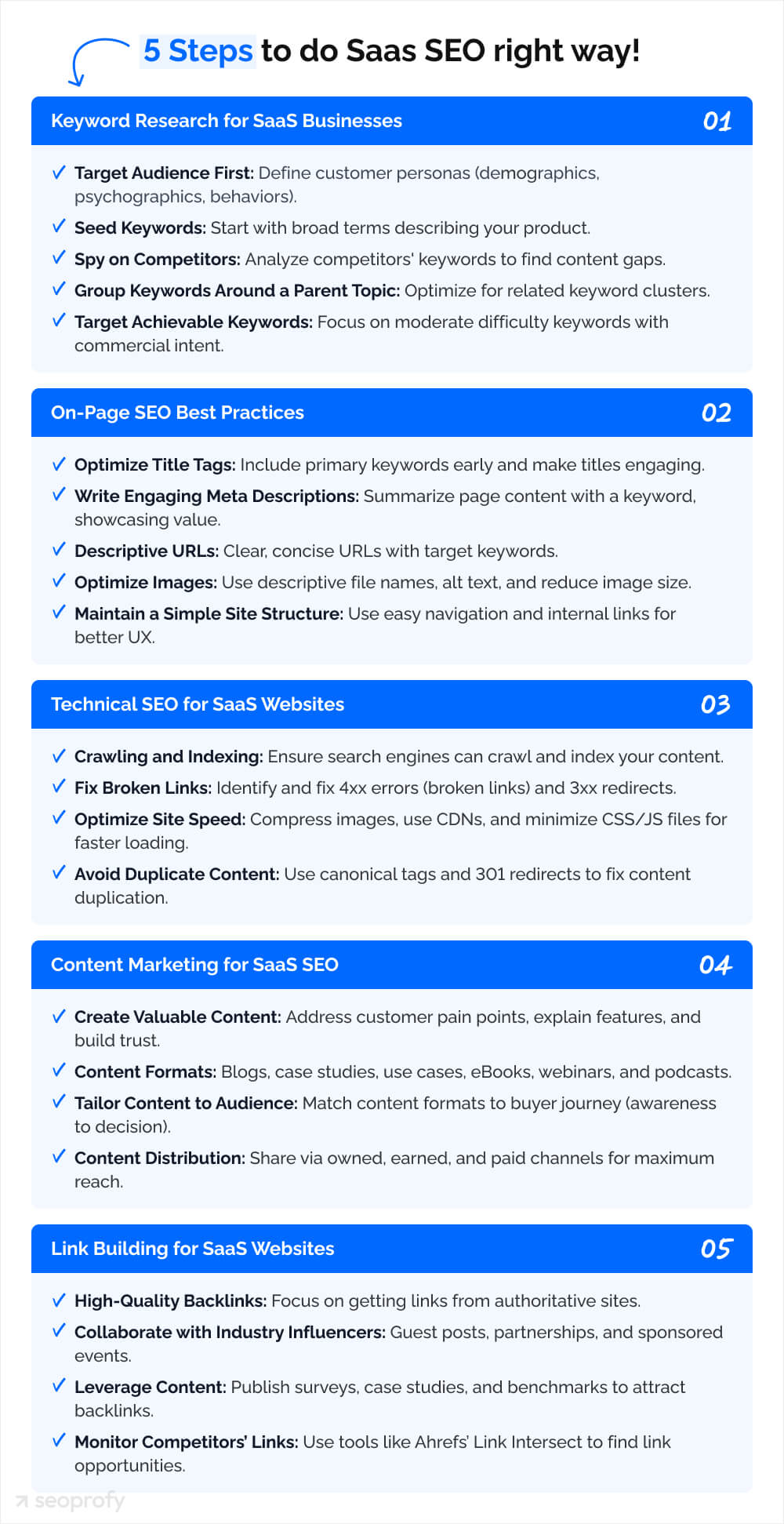
Keyword Research Strategies for SaaS Websites
The starting point of optimizing your website is SaaS keyword research. It’s when you analyze relevant terms and phrases people use to find products like yours and see where those searches fit within their decision process. This helps you understand what to write about and how to map your content to different intents. Here’s how you can approach it:
Define Your Target Audience
First and foremost, you need to get clear on who you’re targeting. Start with customer personas — fictional profiles of your users. These help you picture who you’re talking to. Include details like:
- Demographics: Age, location, job, income.
- Psychographics: Interests, hobbies, values.
- Behaviors: Online habits, search patterns, favorite platforms.
- Needs: What problems do they face? What goals are they chasing?
You can use free persona templates from tools like Miro to make this process faster.
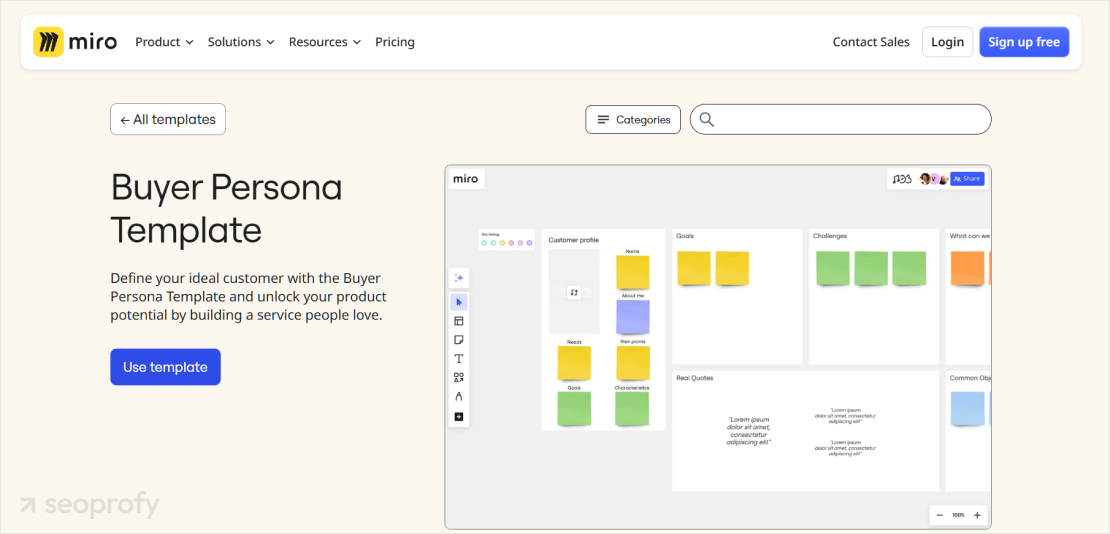
Now, you’re probably wondering where you can find data. First, start with the existing audience you have in GA4 (Google Analytics 4). Here, you can see who your visitors are, what pages they visit often, and what region they’re coming from.
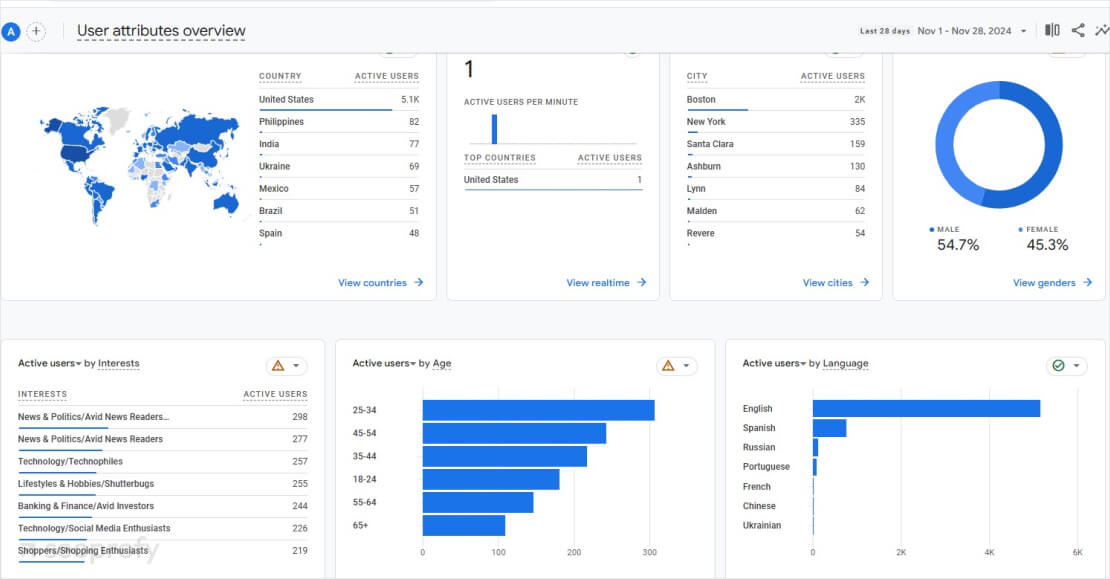
If you want to get even more details on your audience, you can use tools like Semrush’s One2Target (best if you already have their paid plan, as the tool is not free) or SparkToro (free for five searches per month).
SparkToro is great for B2B SaaS SEO because it shows where your audience spends time online — the websites they visit, social accounts they follow, and podcasts they listen to. They also have a feature called Topics that shows what content your audience cares about most.
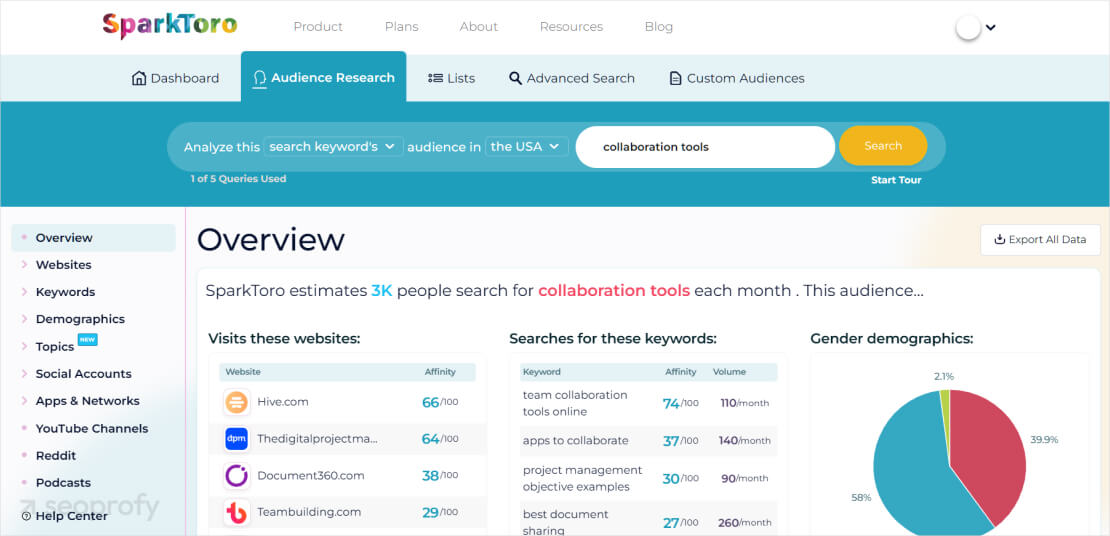
When you define your audience well, everything else gets easier. You’ll be able to offer content that speaks to them and products that solve their problems. On top of that, your marketing will meet them where they are.
Start with Seed Keywords
Seed keywords are general terms that describe your product. Let’s take a project management tool as an example. You might start with a basic keyword like “project management.” To brainstorm some more ideas for your main search terms, you can try to answer these questions:
- What is your SaaS business about?
- How would you like people to find you on Google?
- What features/functionality does your product have?
- What problem do you solve?
Next, you can use free keyword research tools like Google Keyword Planner or paid ones like Semrush’s keyword magic tool to find similar terms and long-tail variations.
Spy on Competitors
You don’t have to reinvent the wheel. Quick competitive analysis can help you find relevant keywords that already work well for similar businesses. Simply go to their top-performing pages in Ahrefs’ Site Explorer and check if there are any potential content gaps in your strategy:
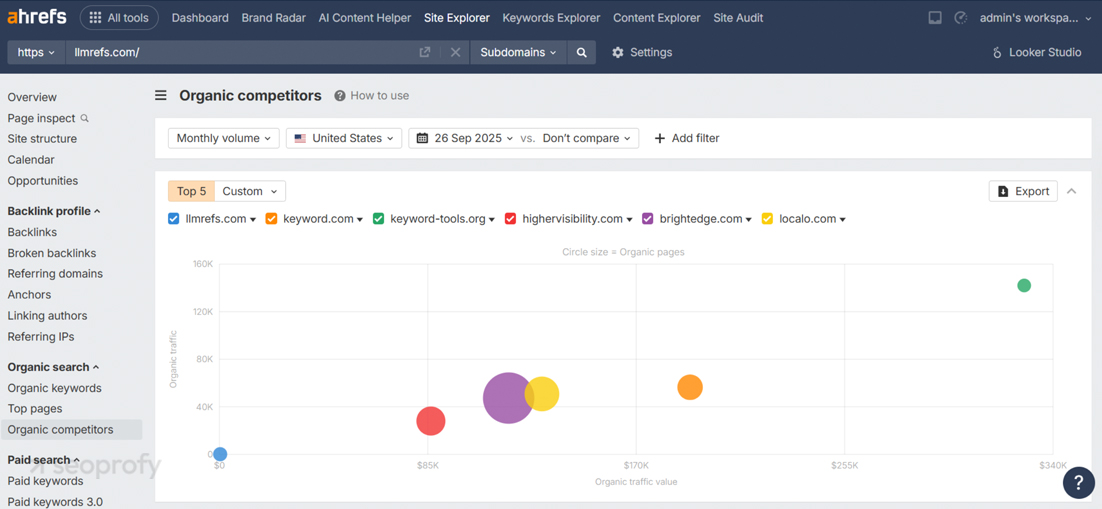
Group Keywords Around a Parent Topic
Keywords don’t exist in isolation — they’re part of broader topics. In the screenshot below, you can see how “best project management software” is a parent topic for related keywords like “free project management software” or “construction project management tools”:
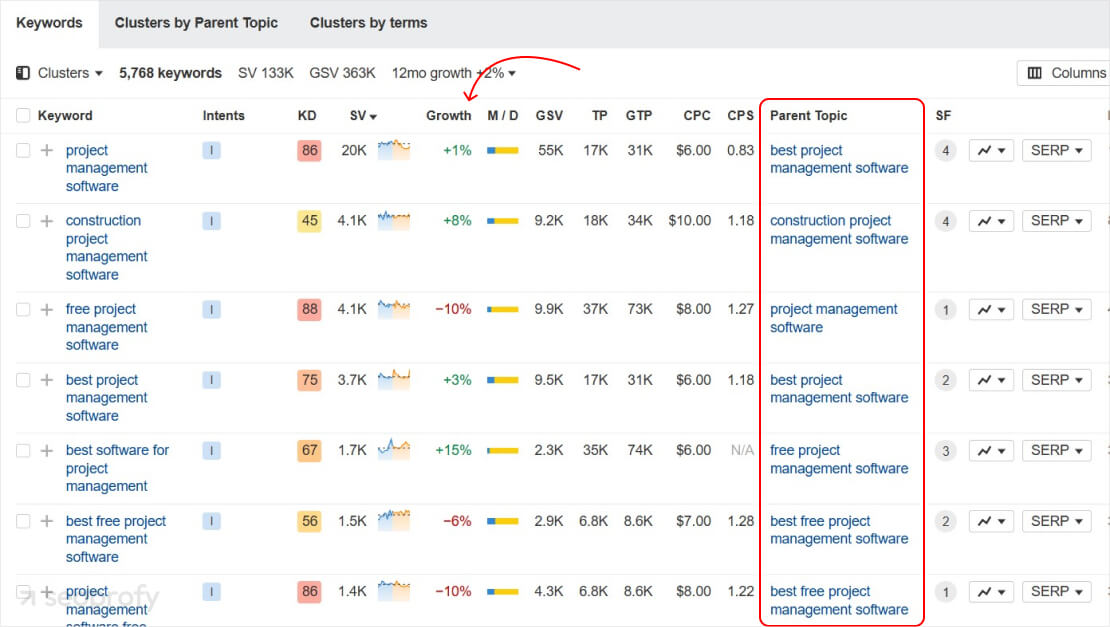
When your content touches on multiple related search queries, you can rank for an entire cluster rather than just one phrase. For example, a single blog post on “The Best Free Project Management Tools for Small Teams” could target several keywords at once.
Target Achievable Keywords
When selecting the keywords for your B2B SaaS SEO campaign, it’s a good idea to evaluate the following SEO metrics:
- Search volume: High-volume keywords bring more traffic, but they also have stronger competition. So it’s better to strike a balance between the two.
- Keyword difficulty (KD): The higher the number, the harder it’ll be to rank for it. Best approach? Focus on keywords with moderate difficulty that are achievable for your current domain authority.
- Commercial intent: Use CPC (Cost Per Click) data to determine which keywords are most likely to convert into leads or sales.
Not every keyword is worth chasing. Some are too competitive, while others might not bring in the right audience. For example, “free project management software” has a KD of 83. Even though it has a decent search volume, ranking for it would be unrealistic for a new website:
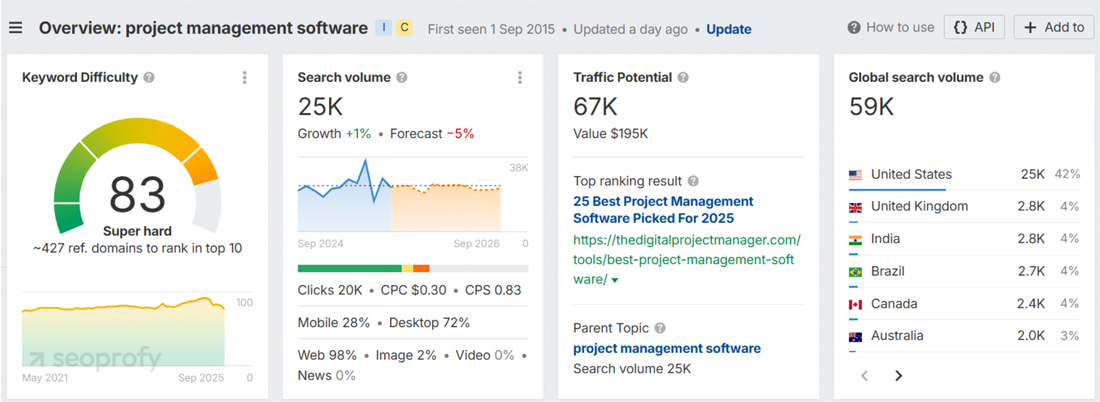
Align Keywords with the Marketing Funnel
An effective SaaS SEO strategy works hand in hand with the sales funnel and moves potential customers from discovery to action. At the top of the funnel, they’re just starting to realize they have a problem. By the time they reach the bottom, they’re fully aware that your solution is what they need.
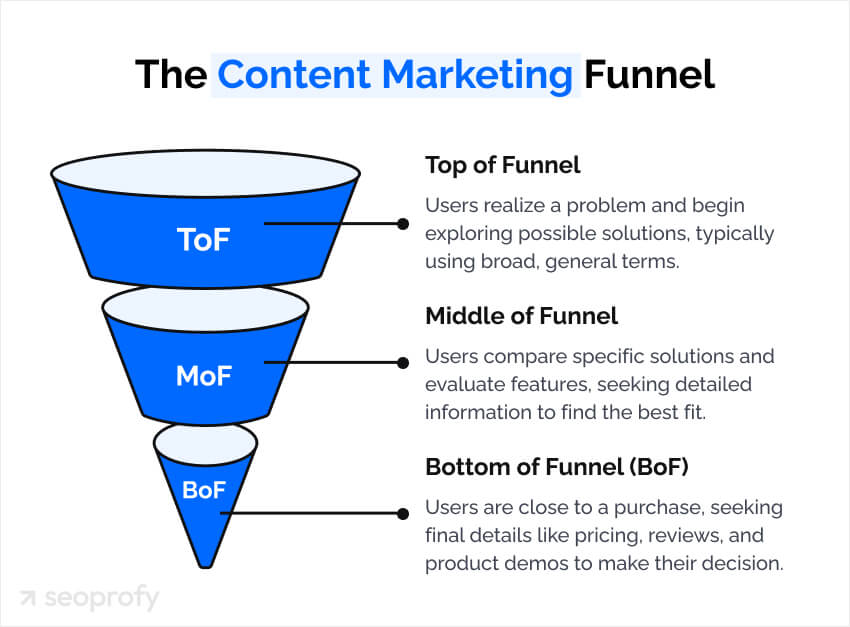
Understanding these stages can help you target the right keywords and design a content strategy that attracts and converts leads as they move along the buyer’s journey. Let’s start with the first one:
Top of Funnel (ToF) or Awareness Stage
When people first realize they have a problem, they start searching for possible solutions. This is when you need to think like your audience and figure out what they’d search for. For example, Notion targets these informational keywords:
- Content calendar template
- Project management for startups
- Note-taking app for students.

These are the kinds of things people look up when they’re exploring options to get organized, but don’t have a specific product in mind yet. At this stage, content like blog posts, simple guides, and free templates work best.
Middle of Funnel (MoF) or Consideration Stage
Now, your audience knows there are solutions out there. They’re actively comparing their options to find the best fit. At this stage, the keywords people use are more specific because they’ve already done some research. They’re looking for solutions or comparing options, for example:
- Notion vs. Trello
- Best app to create workflows
- Best-rated live chat tool for startup companies.

This is the stage where you need to show your USP (unique selling proposition) and how your product positions against other options. Therefore, the content types used at this stage are comparison articles, case studies, feature breakdowns or listicles, and reviews.
Bottom of Funnel (B0F) or Decision Stage
This is where things get serious. Your potential customers researched their options, evaluated different tools, and are almost ready to pick the winner. All you need to do now is nudge them with content that shows, “you’re the one.”
Think about what questions someone might have before committing. They’ll want to know things like:
- How much does it cost?
- What do real users say about it?
- Can I see a demo or try it before I buy?
Again, Notion does a great job targeting these decision-stage needs. For example, they rank for search queries like:
- Notion pricing
- Notion demo
- Notion reviews.

At this stage, your content should clear up any doubts, answer lingering questions, and give people the confidence to choose your product. The type of content that works best for BoF keywords is feature and landing pages, case studies, and FAQs.
On-Page SEO Best Practices
SEO is usually split into two parts: on-page and off-page. On-page SEO for SaaS is everything you can control on your website — writing great titles, optimizing your URLs, and placing internal links strategically to help visitors navigate your site. Off-page SEO, on the other hand, happens outside your website, like building links or getting your content shared.
The great thing about on-page optimization is that it’s entirely in your hands. Let’s now go through some practical SEO tips you can follow to enhance your rankings and overall performance.
Add Your Main Keywords in Titles
Your title tags are one of the most important parts of on-page SaaS SEO. They show search engines and users what your page is about at a glance.
Your title should be clear, concise, and engaging enough to encourage clicks. Another best practice is to include your primary keyword, ideally at the beginning, as seen in the screenshot below:
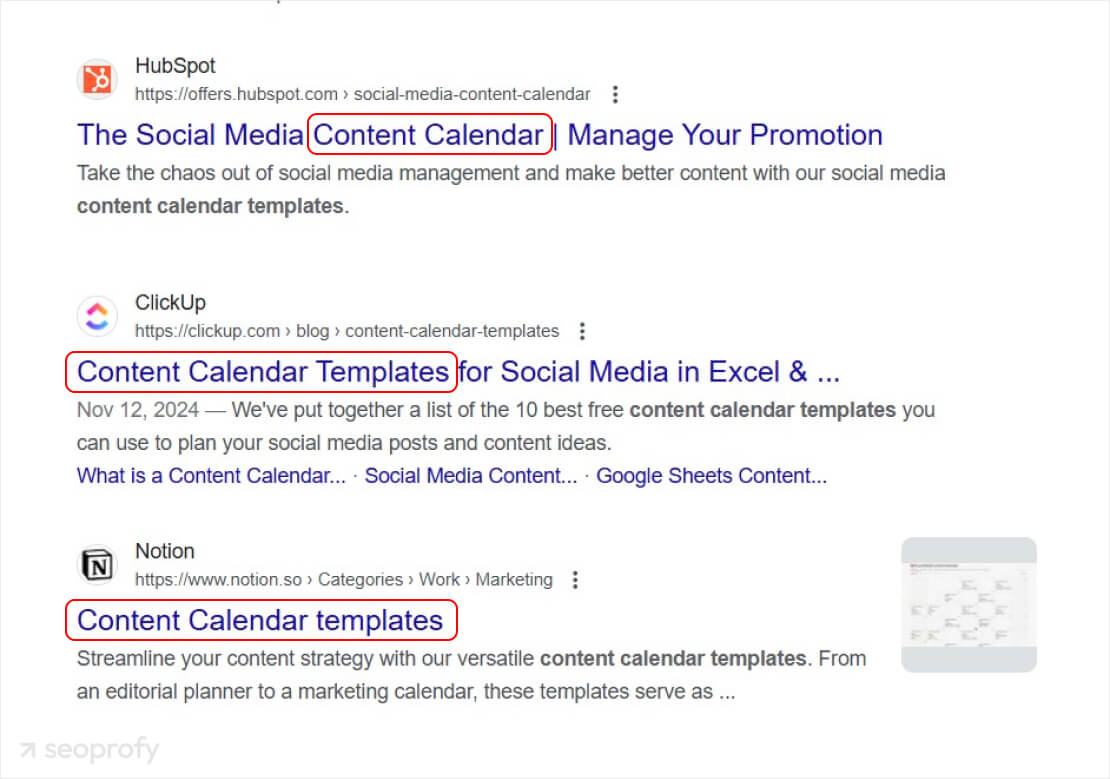
Write Engaging Meta Descriptions
Your meta description should provide a quick summary of your page content and contain a keyword to match the user’s search query. You can think of it as your pitch to searchers: “Here’s why you should click this link.”
You may add some benefits of your product here or show users the value they’ll get if they visit your page. Let’s look at some examples from the leading SaaS companies:
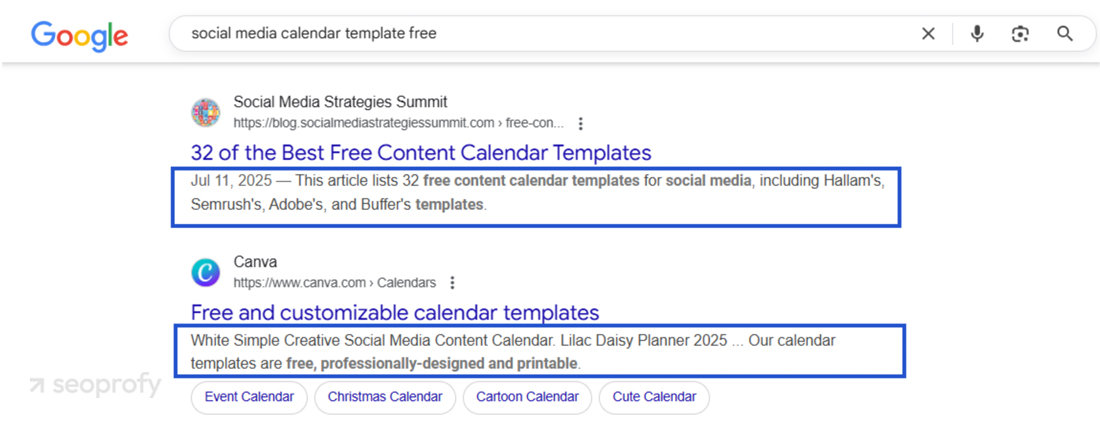
Adding your keywords to the meta description also helps your SEO, as Google understands better what your web page is about and can show it in search engine results pages for relevant searches.
Use Descriptive URLs
URLs are more important than they seem for your SaaS SEO performance. A well-structured URL helps search engine bots understand your page’s context and enables visitors to find their way around your site.
Some CMS platforms, like WordPress or Wix, automatically generate URLs for your pages. Although convenient, these auto-generated links are not always SEO-friendly. So it’s better to take it into your own hands and create URLs that:
- Are clear and descriptive
- Include your target keyword
- Don’t contain irrelevant numbers or characters.
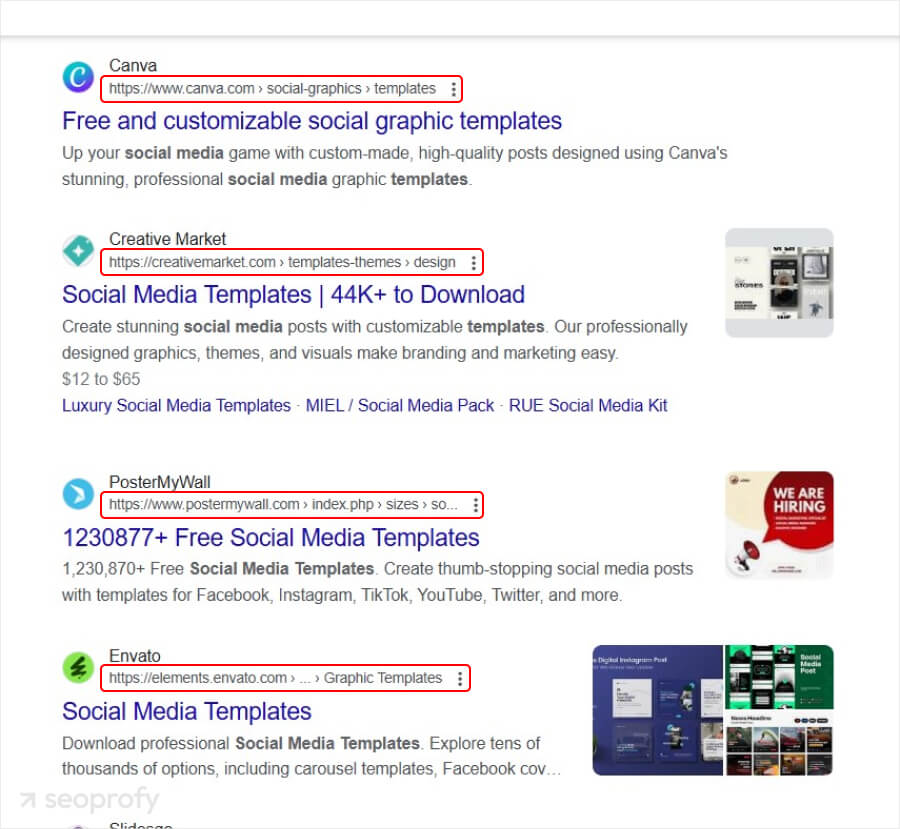
Optimize Your Images
Images make your site look more professional, but they can also benefit your rankings if optimized correctly. Start by renaming your image files with clear, descriptive names. Instead of something generic like “image123.jpg,” use “team-planning-tool.jpg.”
Don’t forget about alt text. Alt text is a short description of the image that helps make your site more accessible and gives Google additional context. Finally, reduce your image sizes to improve loading times and user experience.
You can use tools like Squoosh to compress images without losing quality. Whenever possible, save your images in WebP format — it keeps the quality high while reducing the file size.
Maintain a Simple Site Structure
Site structure is the way you organize and present content to visitors. Google bots rely on it to rank your content. It also helps users find what they’re looking for and improves UX. Here are a few SaaS SEO tips to keep in mind:
- Use a menu that leads directly to important areas like features, pricing, or support. When people can easily find what they need, they’re more likely to spend time on your site.
- Place internal links to send link equity to important pages and also help visitors better navigate your site.
Technical SEO for Saas Websites
We can’t state enough how crucial SaaS technical SEO is for your success. If bots can’t crawl or index your site properly, all the great content you create will remain invisible. Let’s go through the most important technical aspects you need to get right.
Crawling and Indexing
Search engines rely on crawlers (also called bots) to explore websites. Crawlers move through your site by following links, discovering pages, and understanding how everything is connected. But finding the pages is only the first step — next comes indexing.
Indexing is when search engines store the pages they’ve crawled in their database so those pages can appear in search results. If a page isn’t indexed, it won’t show up when people search for related keywords. Certain issues can block crawling and indexing:
- JavaScript-heavy pages: If your site uses JavaScript to load content, crawlers might not see it properly unless you use solutions like server-side rendering (SSR).
- Misconfigured robots.txt files: These files tell crawlers which pages they can or cannot access. If set incorrectly, important pages might be blocked.
- Noindex tags: These tags instruct bots not to index specific pages. Be careful not to accidentally add them to important content.
To check how well your site is being crawled and indexed, use the Crawl Stats report in Google Search Console. For this:
- Open Google Search Console.
- Navigate to Settings.
- Look for the crawl stats section.
- Click on Open Report.
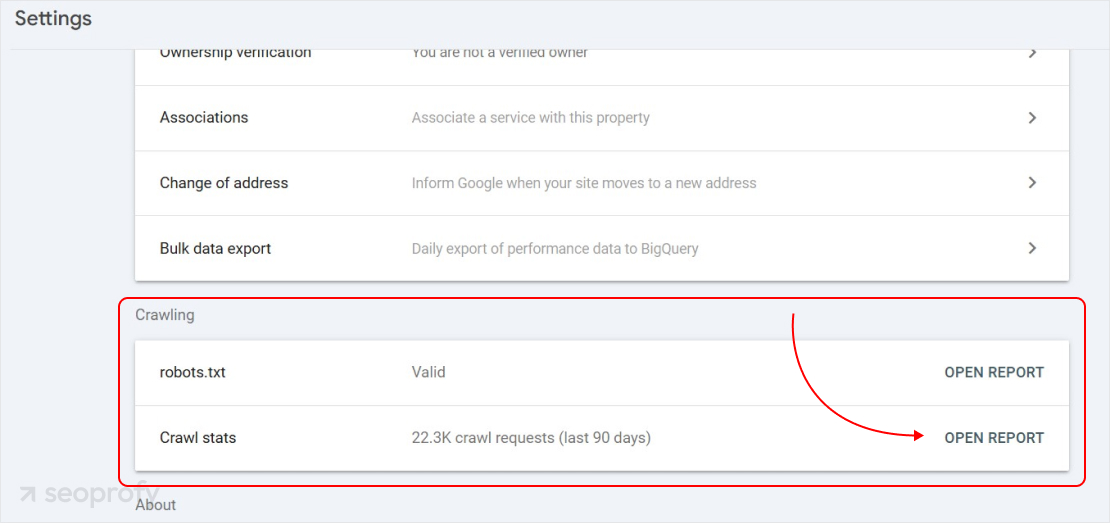
Once inside the report, look for the following:
- 3xx redirects: SaaS software websites often reorganize content, which can lead to a lot of redirects. To keep things simple, avoid redirect chains like A → B → C → D and redirect loops (where the pages keep sending users back and forth, like A → B → A). If you find these issues, update the redirects so they go straight to the final page.
- 4xx errors (broken links): Look for status codes that start with “4”. These mean something’s wrong on the user’s end, like a page that doesn’t exist anymore (404 errors). If you see broken links, update the link to point to the correct page or remove it altogether if it’s no longer relevant.
Site Speed Optimization
Page speed directly impacts user experience on your site and can improve conversion rates and search engine rankings. But if your web page takes too long to load, visitors might leave, and Google could rank your pages lower. To see how your site is performing, you can use tools like PageSpeed Insights.
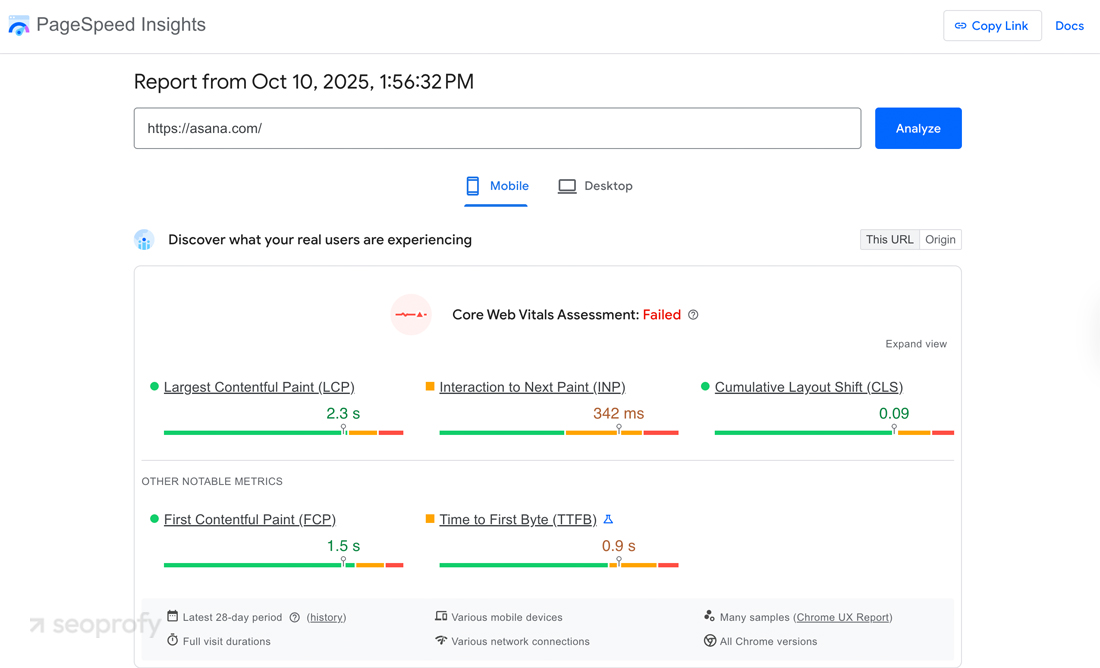
If you scroll down the report, you’ll find detailed diagnostics of your website as well as suggestions on what to fix:
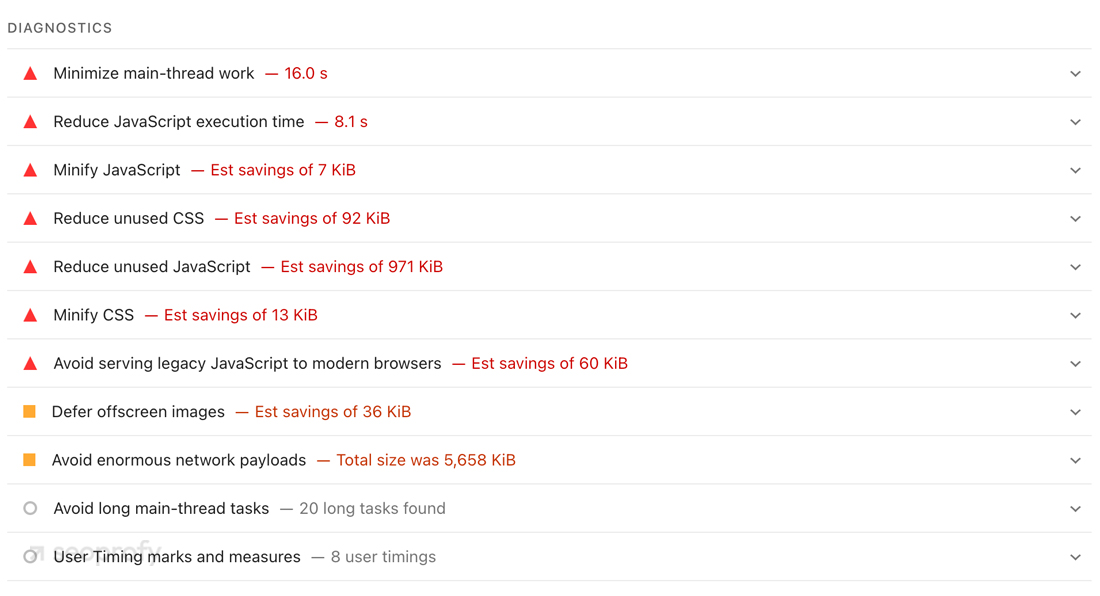
You can also try some of the following best practices to optimize your SaaS website for technical SEO:
- Minimize JavaScript and CSS files to reduce loading time.
- Enable browser caching so repeat visitors experience faster load times.
- Use a content delivery network (CDN) to deliver content quickly across regions.
Duplicate Content
In SEO for SaaS companies, duplicate content appears when the same or very similar content appears on more than one page of your site. This can confuse search engines and dilute your visibility, as they won’t know which page to show in search results.
To find and fix duplicate content, you need to first log into your GSC (Google Search Console) account and go to Pages under the indexing section. Then, look for issues related to duplicate content:
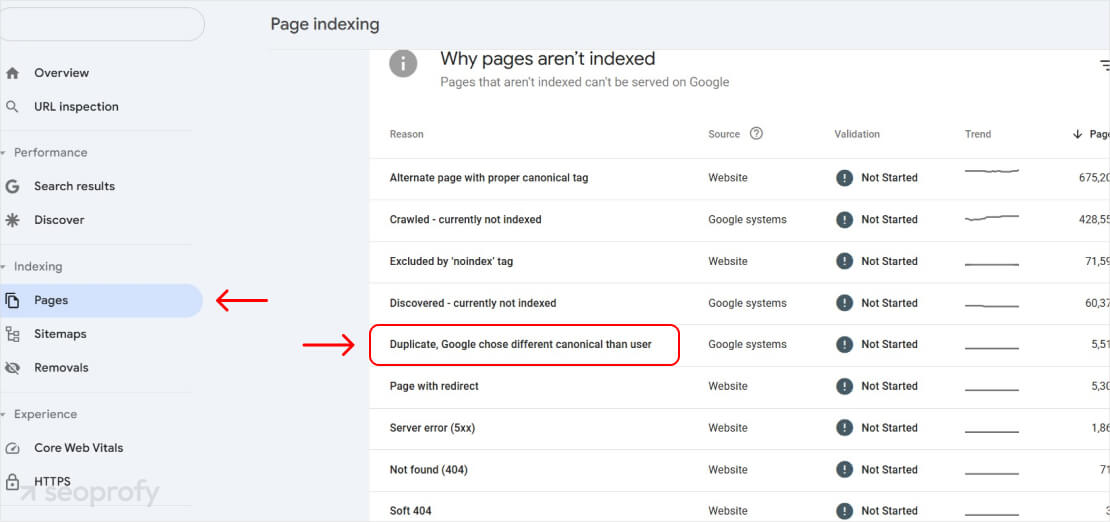
Once you have identified such pages, try to do the following:
- Add a canonical tag to the page you want Google to prioritize. It’s like saying, “This is the main page — ignore the others.”
- Create 301 redirects to send both users and Google bots to the correct page.
If your website uses subdomains, such as for blogs, support pages, or staging environments, consider whether these pages should appear in search results. Indexed subdomains can sometimes cause duplicate content issues. To manage this, you can apply noindex tags to pages on subdomains that aren’t meant for search engines or set up rules in your robots.txt file to block unnecessary indexing.
If this feels like a lot to handle, outsourcing SEO can help make sure everything is set up correctly. The next step? Creating high-quality content that turns visitors into leads.
SaaS Content Marketing
One of the main ingredients of a solid SEO strategy is undeniably content. So why is it so important? The main reason is that the buyer’s journey in this market is more complex. While in ecommerce stores, for example, category and product pages do most of the heavy lifting, the situation is different for software businesses: they need to support a longer consideration process.
People who are looking for a software solution are not ready to buy the first time they land on your site. They’re researching. They want to learn what your software does, how it fits into their workflow, and why it’s better than the alternatives.
You also need to consider that they aren’t just evaluating the tool — they’re looking at the long-term value, customer support, and integrations that come with it. That’s why your content needs to:
- Explain how your product solves their problems
- Build trust through case studies and testimonials
- Position your brand as an authority.
How to Create a SaaS Content Marketing Strategy?
Since the buyer’s journey in SaaS isn’t always a straight line, your SEO content strategy needs to be flexible enough to meet potential customers where they are. It begins with defining your goals, followed by creating valuable content and distributing it to reach a wider audience.
Determine Your Goals
Setting clear goals helps you choose the right content types to achieve the results you’re aiming for. For product businesses, brand awareness and lead generation are often the top priorities:
- Brand awareness: The primary goal of SEO for SaaS startups is to help people find you. If they don’t know you exist, they can’t buy from you. Blogs and videos are great ways to get the word out.
- Lead generation: After getting their attention, the next step is to turn them into leads. Here, you can try formats such as tutorials or webinars that require an email to access.
- Retention: SEO doesn’t stop once a user signs up. Keep your content fresh and helpful so people continue learning new ways to use your product. Updates and educational articles can remind existing customers why your software is worth keeping.
Decide on Content Formats
Different formats serve different goals in SaaS content writing, and below, we’ll share the ones that consistently perform well for software companies.
Blogging
This is one of the most common formats in SaaS content marketing. It not only improves your SEO but also increases retention rates by 32%. For example, ClickUp’s blog is packed with productivity tips and detailed guides, all tailored to their target audience:
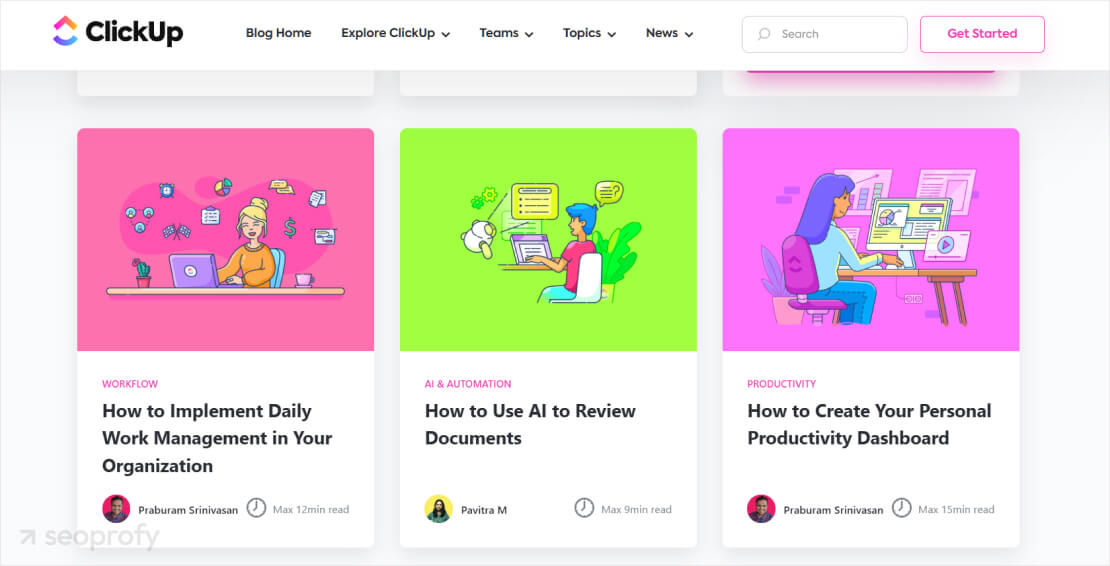
Be careful with AI content. There may be penalties from Google.
Ebooks and Webinars
These work well for lead generation because they provide valuable information that your audience wants. In return for access, you can ask for their email address.
This way, they get the resources they need, and you get a way to stay in touch and nurture a connection with them. One SaaS company that often creates ebooks for readers is HubSpot:
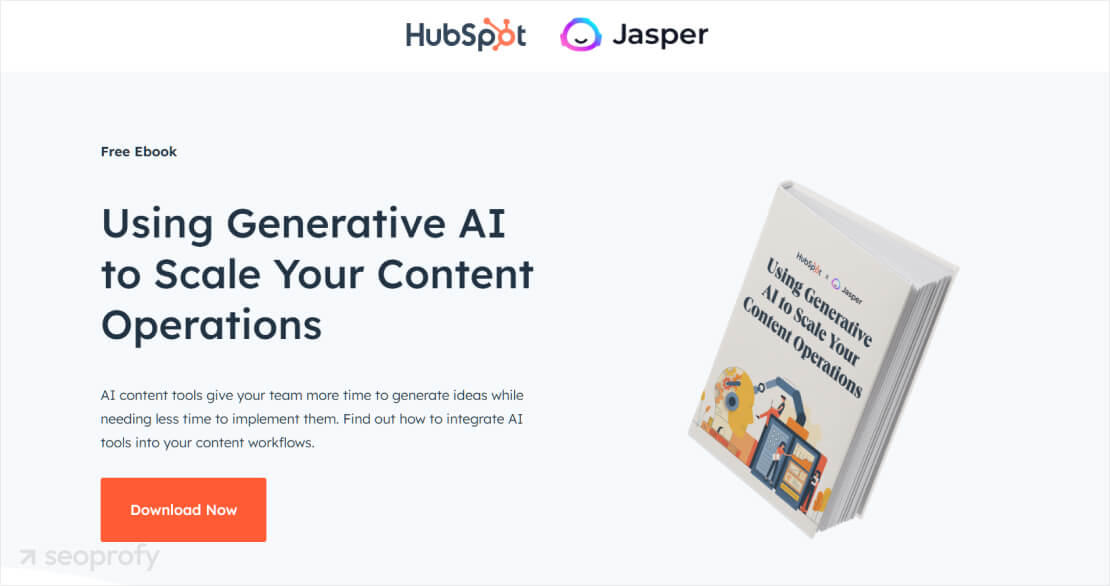
Case Studies
Another content type that can drive more subscriptions for product companies is case studies. These are great because they show how your software solves real-life problems and how other clients have already benefited from it.
Let’s see how Asana does it. In their case study with Zoom, they mention how using Asana saved the company 133 weeks per year. It’s a practical way to show potential customers what’s possible with their software:
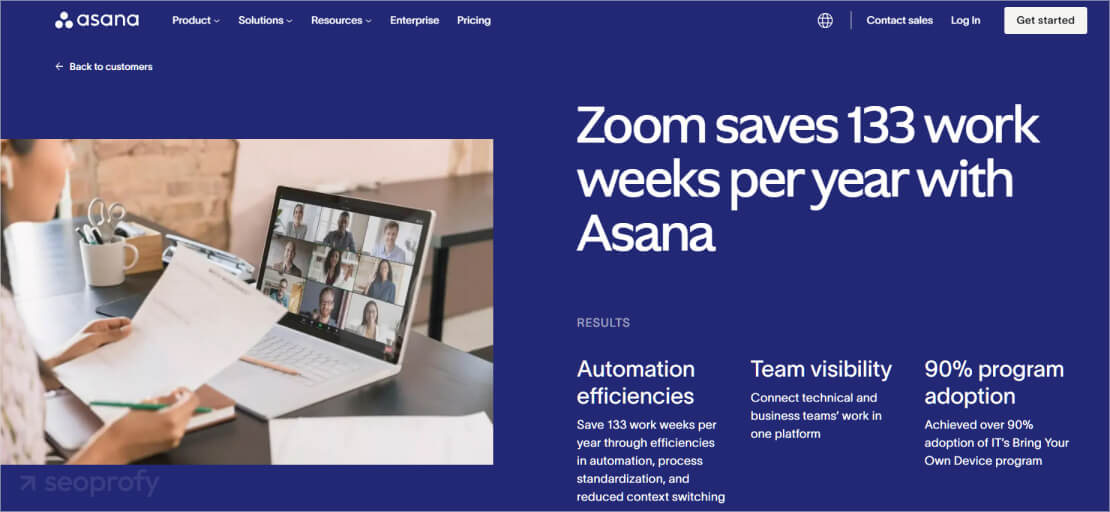
Use Cases
An effective SaaS SEO content strategy often needs to cater to more than one audience, each of whom cares about a different aspect of your tool. Use case content helps you talk to them directly. It gives you space to show how the product fits into their workflow and supports the outcomes they care about. Here’s an example of how Typeform does it:
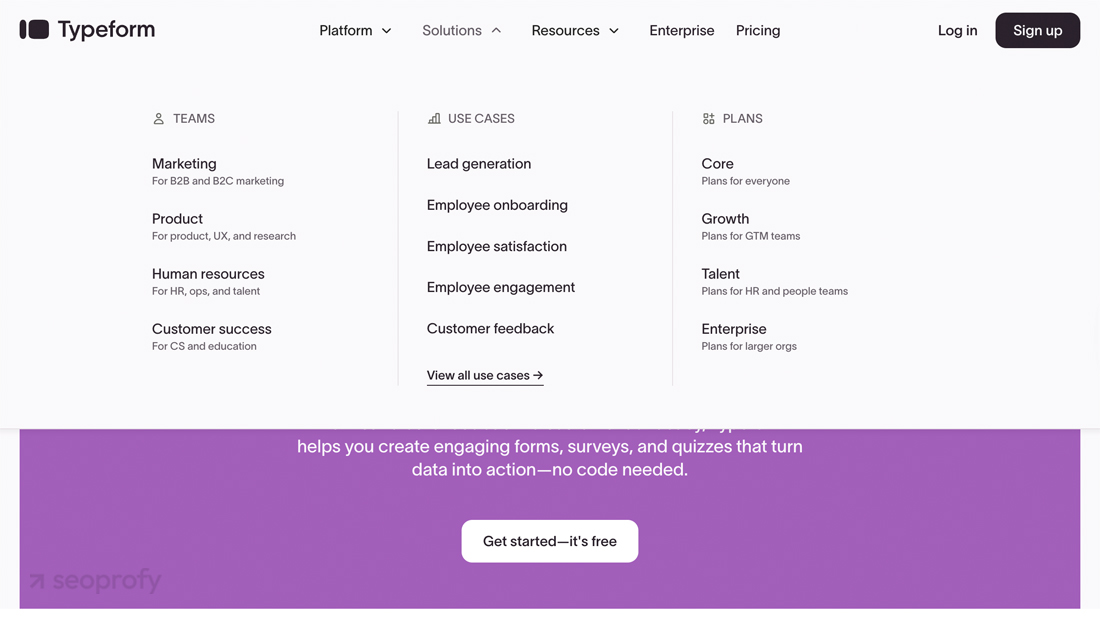
This format can also support SEO by targeting mid and bottom-funnel searches. People often look for tools that integrate with specific platforms or support a certain function, and these pages can capture that demand directly.
Podcasts and Expert Round-Ups
Finally, you can test the waters with newer formats like showing up on relevant podcasts. It’s a great way to connect with your audience on a personal level and talk about your first-hand expertise.
For example, Shopify launched its own podcast called “Shopify Masters.” They use it to share interviews and success stories from entrepreneurs who’ve used Shopify to grow their businesses.
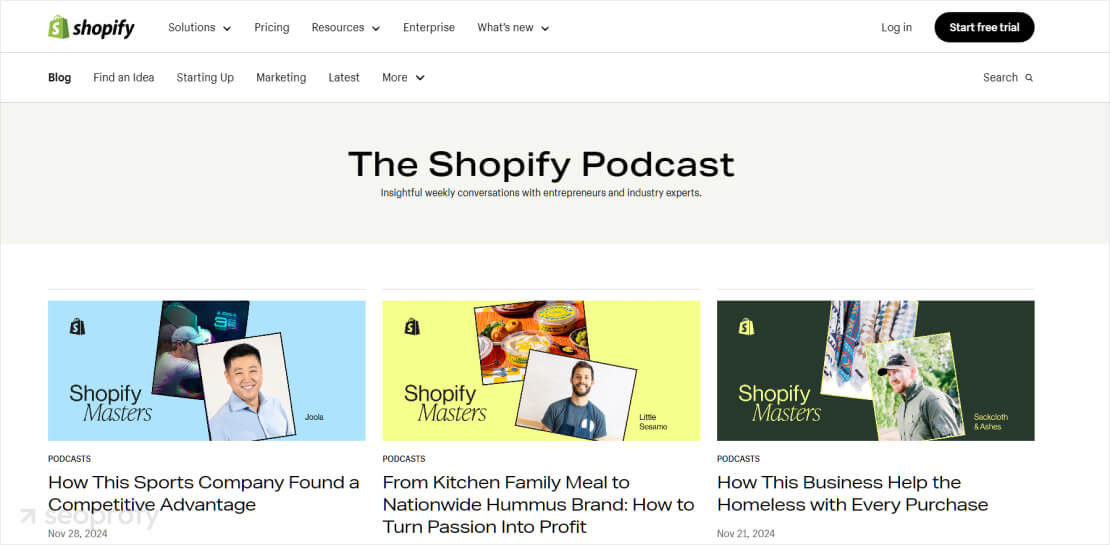
Create a Content Production System
Many businesses create SEO-optimized content without a clear plan, which often leads to wasted effort and missed goals. The best way to do SEO for SaaS companies is to create a monthly editorial calendar or a content map that outlines what you’ll produce, including topics, formats, target keywords, and your audience.
Distribute Your Content
Posting a blog and leaving it at that won’t get the results you want. In SaaS content marketing, distribution is just as important as creation. You need to reach as many potential clients as possible, and here are three main platforms where you can share it:
- Owned channels (your email list, website, or blog)
- Earned/shared channels (social media and third-party platforms)
- Paid channels (ads, sponsored content, or influencer marketing).
To help your content perform well, focus on platforms where your audience spends time. Use buyer personas and audience insights to find these and adapt your content to fit. This helps you maximize its impact and reach more of the people you’re trying to connect with.
Link Building for Saas
Link building for SaaS businesses means getting other authoritative websites to link to you. It still is an important aspect of every SEO campaign because Google treats backlinks as one of the strongest signals of authority, and that hasn’t changed.
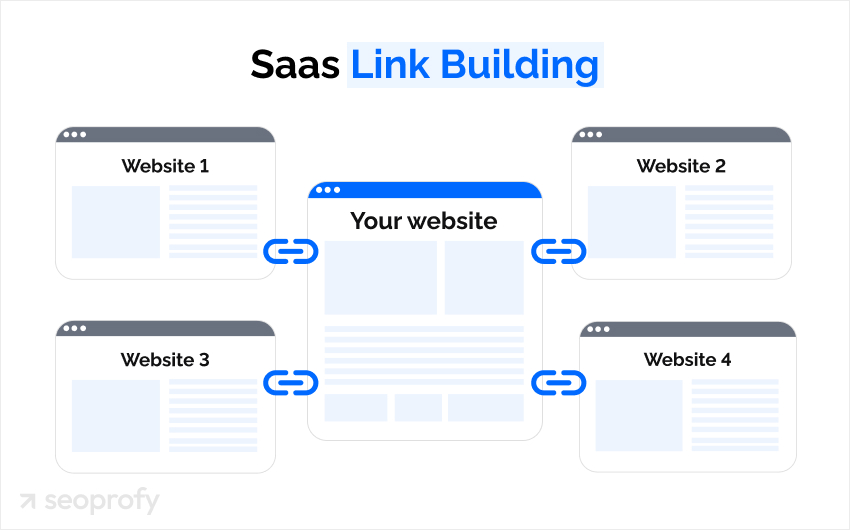
What’s new is that AI tools also look at those mentions when deciding which brands to surface. The more your product appears across reputable sites, the higher the chance it will be recognized and referenced by large language models, too.
The problem is, there’s high competition in the SaaS industry, and getting top rankings on Google is no easy task. For high-demand SEO keywords like “email marketing platform,” Ahrefs data shows you’d need backlinks from over 756 referring domains just to break into the top 10. Sounds like a lot, right?
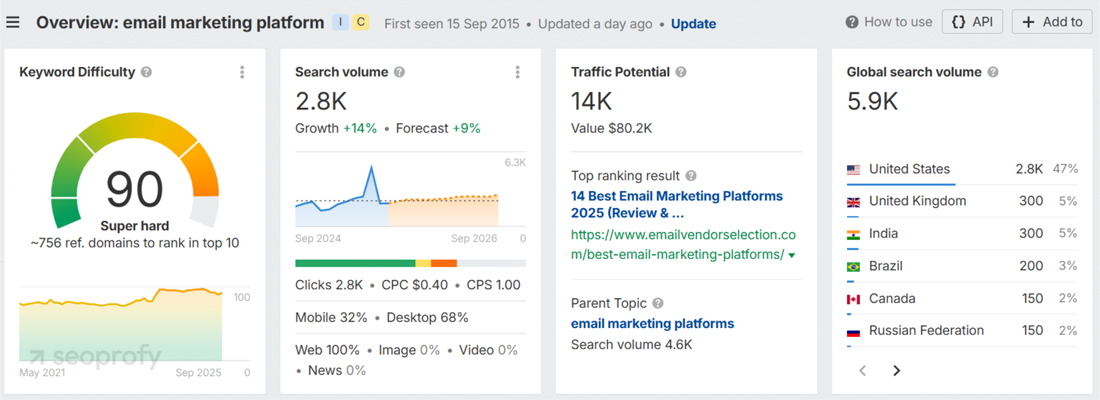
In more competitive areas, such as AI tools, the requirements are even steeper. Some of the websites in this industry have more than 5,000 referring domains.
So what does this mean for your SaaS business? You need to build a strong backlink profile to be able to rank well, build credibility, and get more leads to your site.
If ranking for terms like “email marketing platform” requires over 700 backlinks, then go for less competitive keywords that don’t need many backlinks to rank. Tools like Ahrefs’ filters can help you find these opportunities:
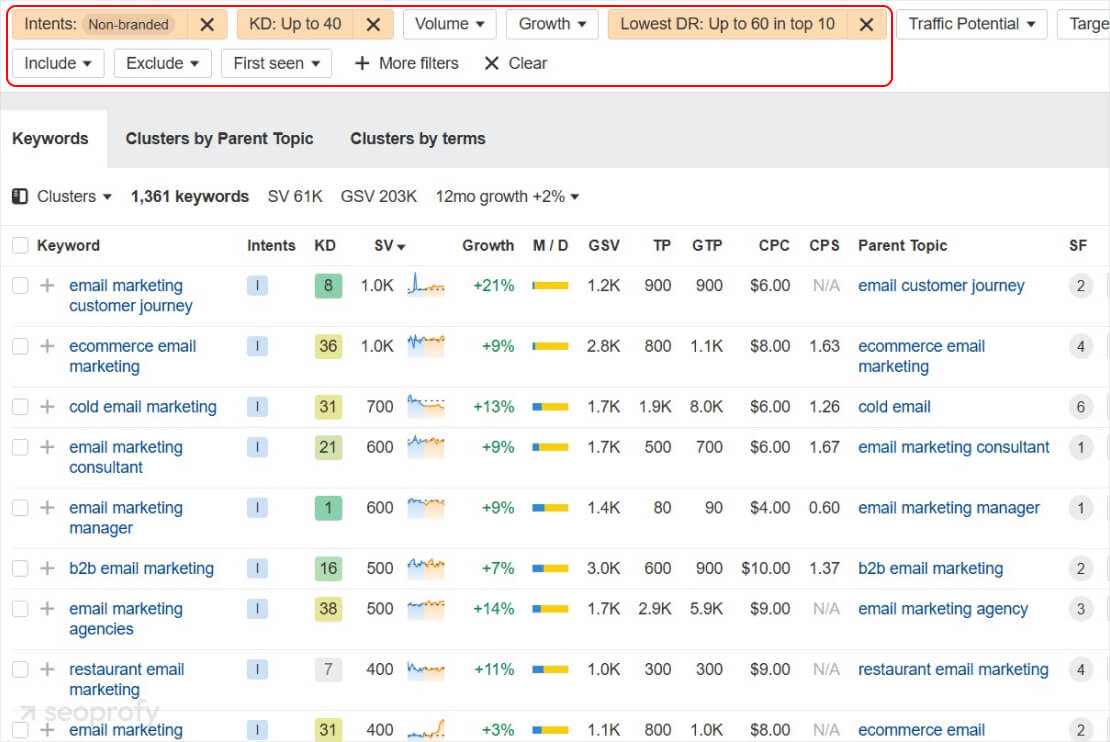
Additionally, you can try some of the proven ways to get more backlinks to your site, for example:
- Share unique data that others can use: Publish more surveys, case studies, or industry benchmarks, as this type of content often gets cited in blogs and articles and drives more referral traffic. We also noticed that proprietary data often gets referenced in AI models.
- Write for trusted sites in your niche: Collaborate with other SaaS companies or blogs to write a guest post for them. You can also use platforms like HARO (Help a Reporter Out) to connect with journalists who may feature your product.
- Reclaim unlinked mentions: Many blogs and directories mention your software without linking to it. You can find these mentions through tools like Google Alerts or Ahrefs. A simple message that thanks them for including your product and asks for a link often works. It’s a low-effort tactic that works surprisingly well.
- Watch your competitors’ link profiles: Your competitors can point you to new link opportunities. Use Ahrefs’ Link Intersect feature to see which domains link to them but not you. Study what kind of content earned those mentions and pitch something more current or useful. Many of those sites already write about your industry, so they’re open to new references.
- Partner with brands and event organizers: Reach out to your integration partners and ask if they can list you on their resource or integration pages. For example, if you integrate with Slack, see if they can include you in their apps and tools directory. At the same time, look for industry-specific conferences or virtual events where you can sponsor and gain exposure through their backlinks.
Try to focus on less competitive keywords if your link profile is far from average.
Advanced SaaS SEO Tactics
In this section, we’ll look at more advanced tactics that are often a part of B2B SEO services:
Conversion Rate Optimization (CRO)
If you see that your website is only attracting traffic but no sales, this means you need to optimize your pages for a better conversion rate. How to do it? You can try out these best practices:
- Simplify forms and ask only for the main information you need (no one has the time to fill out long forms).
- Make your CTAs clear, action-oriented, and visible on the page.
- Test different page elements — like headlines, CTAs, or page layouts — to see what works best.
- Incorporate relevant CTA sections within your webpage.
- Add client testimonials or trust badges to build credibility and reduce hesitation.
- Make sure your site works well on all devices, as mobile traffic often accounts for a large share of your audience.
Additionally, try using heatmaps or session recordings. They show how visitors move through your pages and where attention starts to fade. Tools like Heap or Amplitude can help you see which features attract conversions, while connecting this data with your CRM shows which CTA paths often lead to paid plans.
In the screenshot below, you can see how Cognism places its CTA section. It’s distinctive from the rest of the web page and is highly relevant to their potential customers (B2B professionals looking for a data solution).
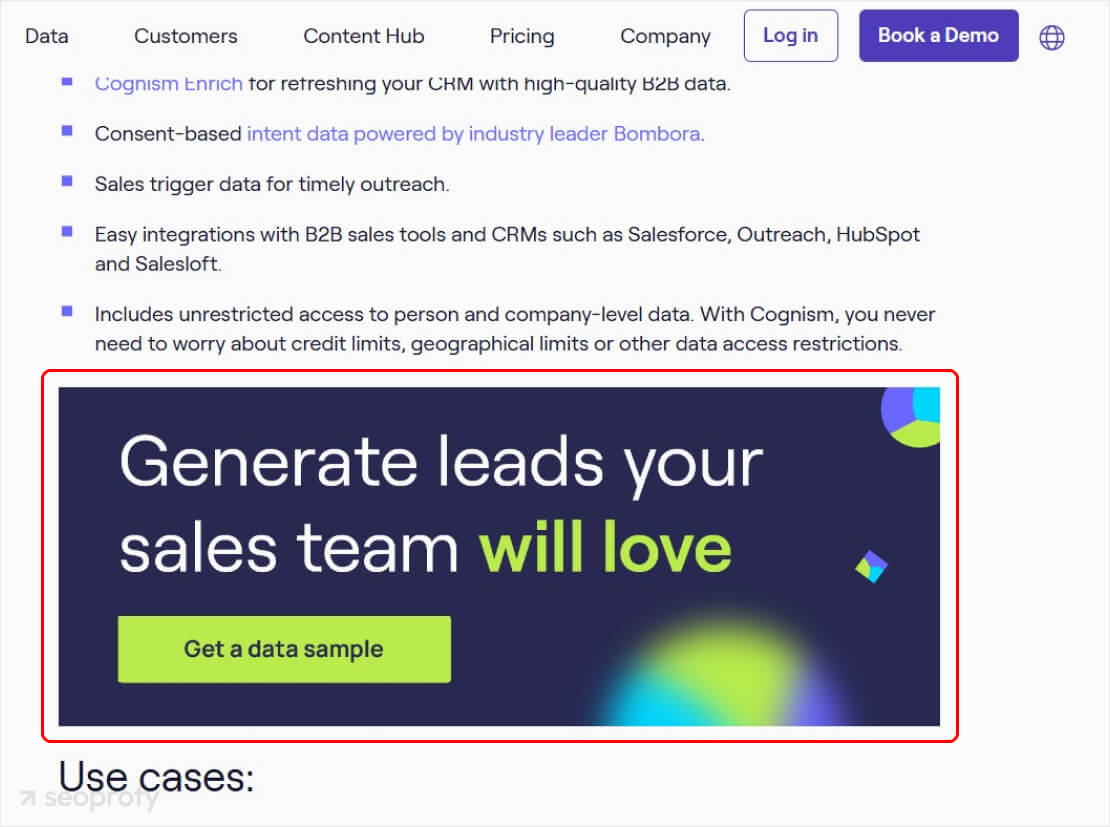
Local SEO and International Expansion
To grow your SaaS business, it’s important to connect with people where they are. A combination of local and international SEO can help you achieve this. Start with local SEO to meet the needs and demands of your target region. Here’s what you can do:
- Create content for local audiences
- Optimize your Google Business Profile
- Use location-based keywords
- Build local backlinks.
If you’re planning to expand into new markets, international SEO for SaaS websites can help you tap into audiences in different countries and languages. This is when you need to:
- Localize your content for a multilingual audience
- Add hreflang tags so search engines show the right language or region version of your site
- Set up geo-targeting in GSC to let Google know which countries or regions your site is targeting
- Create an international backlinking strategy and work with local influencers or websites to build trust in new countries
- Offer local currencies and preferred payment methods to remove barriers for international buyers.
To show you how the localization part works in practice, let’s take a look at Stripe. The company operates in many countries and has a local version of its website for each region. Here’s their page for the U.S., where you can see English copy and dollar-based pricing:
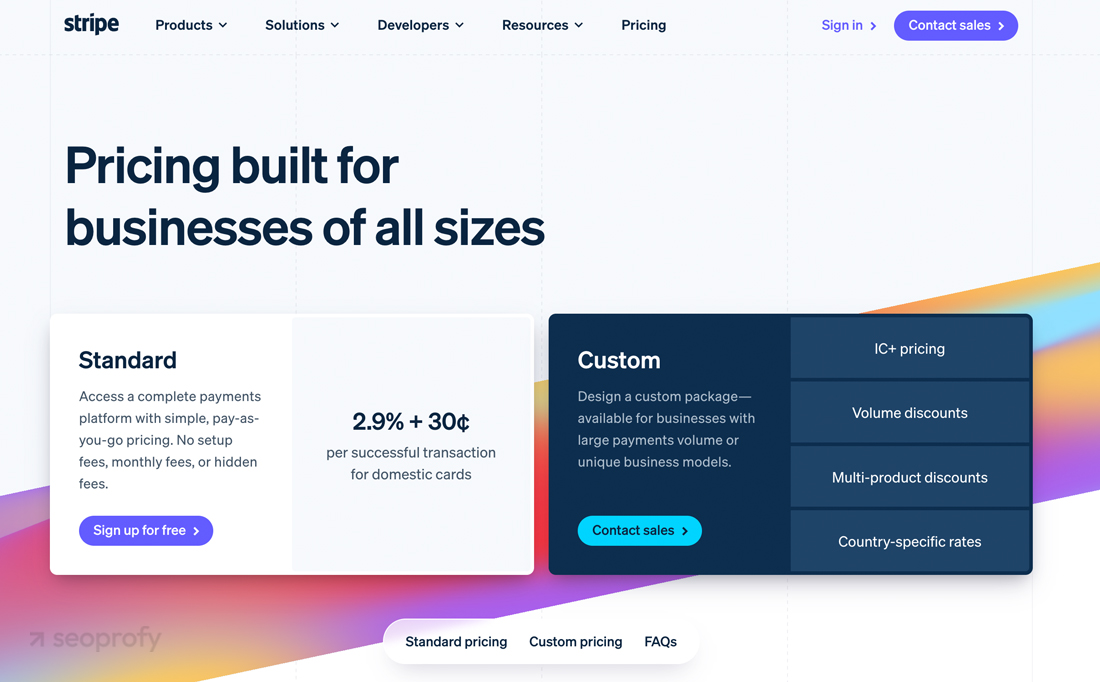
Now compare it to their Spanish version below. Notice how they switched currency symbols and adapted the text to the local language and tone:
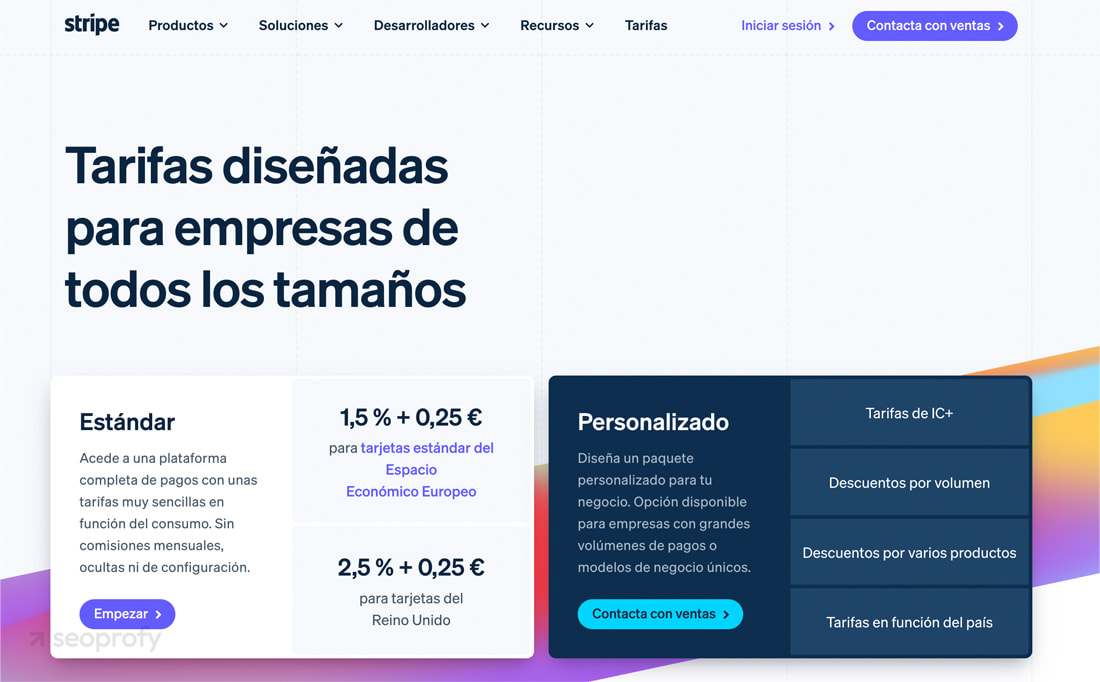
These adjustments make the experience feel native to every market and are an important part of an international SEO campaign. Of course, not every SaaS business will need to go that far right away. For many, a bigger impact comes from improving what’s already on the site, which brings us to our next section.
Update Non-Performing Content
Updating content is a simple yet effective way to improve SEO for SaaS companies. Customers expect up-to-date information, whether it’s about your product or the solutions you provide. Google prioritizes fresh content, too, making it a win-win.
How do you know which content to refresh? Simply open GSC and navigate to the Performance report. Once there, set your date range and look at the pages. Sort them by clicks or impressions to spot those that are not performing well. Then, you can do the following:
- Fix outdated information, broken links, and missing details.
- Add new insights or updated statistics.
- If your keywords are no longer driving traffic, replace them with ones that better match the current search intent.
As a shortcut, you could also ask AI tools to check which pages need to be updated. From your WordPress account, export your title tags or a list of URLs and paste them into ChatGPT. Ask it to review which topics may feel outdated or losing traction. It’s a quick way to pinpoint pages that could use a refresh.
And it’s worth mentioning that updated content helps not only with Google. AI tools value fresh information too and often reference newer pages when generating answers. So, when your content is current, it’s more likely to surface there as well.
SEO Challenges for SaaS Companies
Just like other businesses, software websites have to deal with certain complexities when it comes to SEO. So what are they exactly? Let’s have a look:
- High competition: Many brands are fighting for high-intent terms in the SaaS market. To compete, you need a well-planned strategy that targets long-tail keywords and niche search terms.
- Ever-changing product features: Software products don’t stay in one place; there are always new features, integrations, and updates. If your website and content don’t reflect these changes, potential customers might get confused or miss out on the benefits.
- Technical SEO complexity: SaaS websites often have a lot going on with product details, blogs, FAQs, pricing pages, and support sections. This can make it harder for Google bots to make sense of your site.
- Long sales cycles: Customers who look for software don’t usually sign up right away. They research, compare options, and take their time. To keep them interested, your SEO strategy should offer helpful content at each step — whether that’s blog posts to answer their questions, case studies to show your value, or demos to let them see your product in action.
- International SEO considerations: If your company serves global customers, optimization for international audiences adds another layer of complexity: multiple languages to deal with, different search behaviors, and localization of your content according to region.
- Content relevance and quality: In SaaS, your content should answer the exact questions your target audience is asking and match where they are in their decision-making process.
Measuring SEO Success
All the effort you put into your SaaS SEO strategy only makes sense if you’re tracking SEO results. We recommend monitoring the following metrics:
Keyword Rankings
Keyword rankings show how visible your SaaS website is in search engine results. When your important terms perform well, more potential customers can find you.
To track your positions, you can use free reports in GSC or paid tools like Ahrefs or Semrush. These tools help you see whether your rankings are improving and which queries need more attention.
Organic Traffic
Organic traffic tells you how many visitors are coming to your site through search engines like Google. Ideally, this number should grow over time.
Check your traffic stats in GA4. It will show you how many visitors you get and which pages perform the best. If you notice sudden drops or slow growth, it’s a sign to revisit your content or technical SEO.
Conversions
Traffic and rankings are great, but what matters is the actions your visitors take once they land on your site. Are they requesting free trials and demos, or maybe purchasing directly?
In GA4, you can set up Events to track these actions and mark them as Conversions. For example, you can create an event to track every time someone signs up for a free trial. This helps you see how well your B2B SaaS SEO efforts are turning visitors into potential customers.
Pay attention to your conversion rate — the percentage of visitors who take action. If traffic is high but conversions are low, it might mean your landing pages need to be rewritten or your CTAs aren’t clear enough.
LLM Mentions
Finally, as more people now turn to AI models for research, it’s worth your while to track how often your SaaS product gets mentioned in these tools. Ahrefs lets you do that through their Brand Radar feature, which shows how many times your website was referenced in ChatGPT, Perplexity, Gemini, and Copilot.
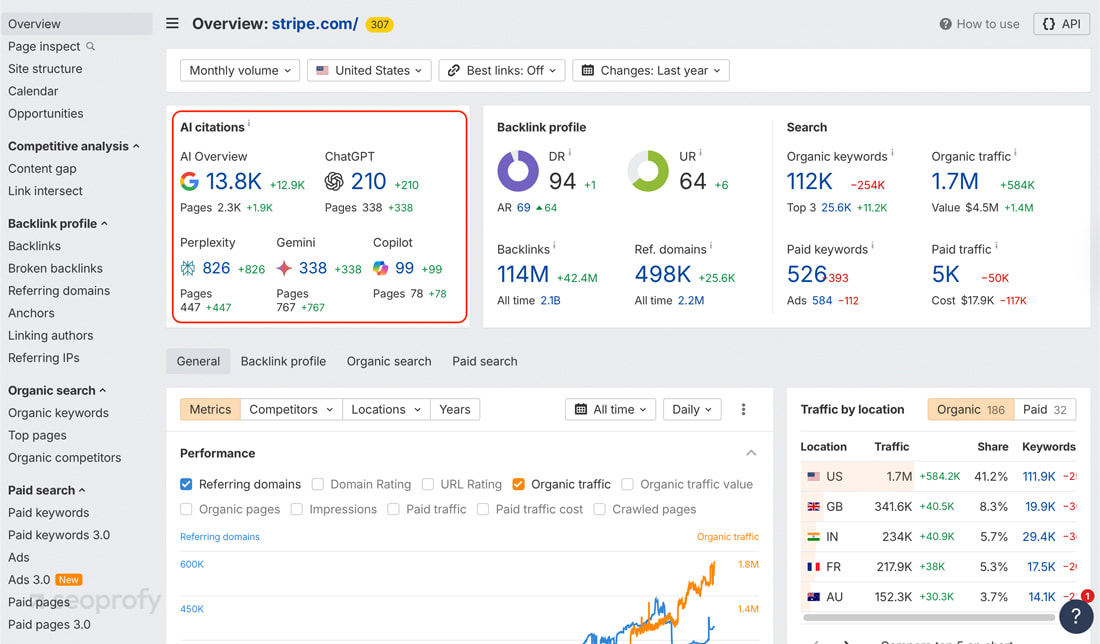
If your product rarely appears or isn’t cited at all, it may be a good time to perform an AI SEO audit. It will help you understand how AI models read your website and what can be improved to increase your visibility there.
Best SEO Tools for SaaS
To make tracking and improving all the mentioned metrics easier, here are some of the best SEO tools you can use:
- Google Analytics 4: See changes in website traffic and user behavior. Track specific actions like signups and downloads to measure engagement.
- Google Search Console: Stay on top of your website’s search performance with data on clicks, impressions, and keyword rankings. Identify and fix crawl or indexing issues that could hurt your visibility.
- Ahrefs: Find keywords with the best potential, track rankings, explore content ideas, analyze your competition, and monitor mentions in LLMs.
- LinkChecker.pro: Check your backlinks and keep track of changes over time. You can also identify any harmful links with this tool.
- Surfer: Optimize your content to rank higher on Google. The tool is not free, but it works great for speeding up the creation of optimized copy.
Common SaaS SEO Mistakes to Avoid
Very often, one or another mistake is made in SEO strategies for SaaS. Here are some of them to watch out for:
- Skipping target audience research: If you don’t know who your customers are and what their pain points and motivations might be, then your content and SEO campaign won’t be effective.
- Neglecting on-page optimization: Elements like titles, meta descriptions, headers, and URLs are small but mighty. Ignoring them can make it harder for people to find your site.
- Mismatched content: Optimizing for keywords that don’t align with users’ intent can lead to lower rankings and higher bounce rates.
- Going too broad: Trying to rank for overly broad and competitive terms can spread your efforts too thin. It’s far better to hone in on specific topics first.
Build Your Winning SaaS SEO Strategy Today
SaaS SEO requires lots of time and resources. But the payoff is often worth it in the long run, especially now when SEO also lays the foundation for how well your brand appears in AI models.
That said, if you prefer to skip the trial and error, why not partner with a professional SEO agency? Here, at SeoProfy, our team has helped numerous software companies increase organic traffic and sales, and we can do the same for you.
We’ll review your site and create a custom SEO strategy to help you attract more leads and paying customers from both traditional and AI search engines. Reach out to us today to learn more.






